| کد مقاله | کد نشریه | سال انتشار | مقاله انگلیسی | نسخه تمام متن |
|---|---|---|---|---|
| 8104870 | 1522155 | 2015 | 13 صفحه PDF | دانلود رایگان |
عنوان انگلیسی مقاله ISI
Life cycle assessment for rainbow trout (Oncorhynchus mykiss) production systems: a case study for Iran
دانلود مقاله + سفارش ترجمه
دانلود مقاله ISI انگلیسی
رایگان برای ایرانیان
کلمات کلیدی
موضوعات مرتبط
مهندسی و علوم پایه
مهندسی انرژی
انرژی های تجدید پذیر، توسعه پایدار و محیط زیست
پیش نمایش صفحه اول مقاله

چکیده انگلیسی
The aim of this study was to assess the life cycle of rainbow trout under three culturing systems including flow-through, recirculating and semi-closed recirculating systems in Iran. The life cycle assessment (LCA) method was found to be suited very well for this purpose. LCA method was used to quantify and compare the potential environmental impacts of culturing rainbow trout in the above three aquaculture systems. Differences were found between the above three systems in terms of water dependence, land competition, feed production processes and energy use. Feed production was found to be the major contributor to the potential impacts such as climate change and acidification in all of the above three systems due to variable feed conversion ratios (FCR, 1.15, 1.47 and 1.57) in flow-through, recirculating and semi-closed recirculating systems, respectively. The results indicated that the semi-closed recirculating system was less efficient than the flow-through system, with a higher level of potential eutrophication (49% greater), abiotic depletion (80% greater) and global warming (82% greater). The recirculating system required about 10 time more material and energy demands compared to the flow-through system. Water dependence in the flow-through system was calculated to be 27 and 3.7 times more than for the recirculating and semi-closed recirculating systems, respectively for the same quantity of biomass production. The major contribution to the land use was feed ingredient production (up to 95%) for the semi-closed recirculating and recirculating system. On the other hand, the land use in the flow-through system on farm rainbow trout production and feed ingredient production were calculated about 11 and 89%, respectively. Therefore, many options exist for improving the environmental performance of these aquaculture systems. The most important measure is to increase the feed and energy efficiency through improvements in rearing modes and the optimisation of feeding practices. It is recommended that excluded impacts such as biodiversity and socio-economic impacts be carefully considered in further sustainability assessments of recirculating and semi-closed recirculating systems and in continuing efforts to improve and develop these technologies on a larger scale.
ناشر
Database: Elsevier - ScienceDirect (ساینس دایرکت)
Journal: Journal of Cleaner Production - Volume 91, 15 March 2015, Pages 43-55
Journal: Journal of Cleaner Production - Volume 91, 15 March 2015, Pages 43-55
نویسندگان
Majid Dekamin, Hadi Veisi, Edwin Safari, Houman Liaghati, Korus Khoshbakht, Mohammad G. Dekamin,